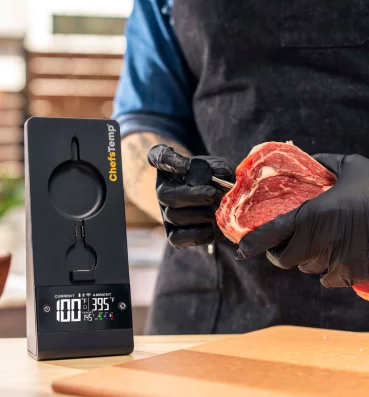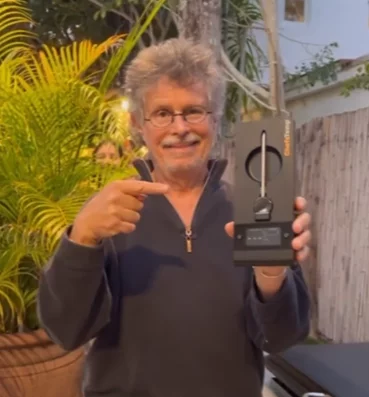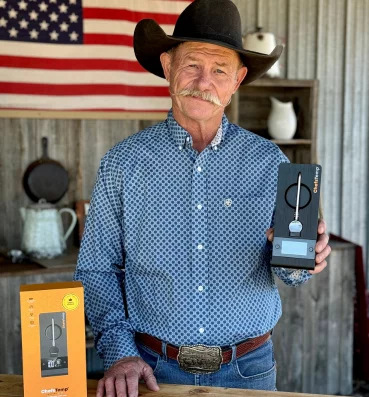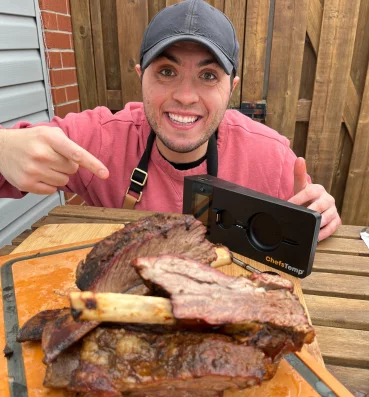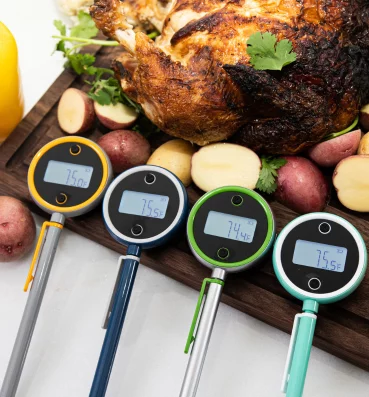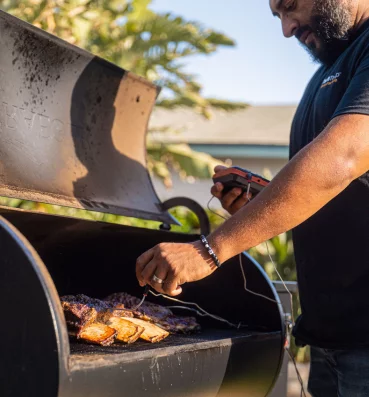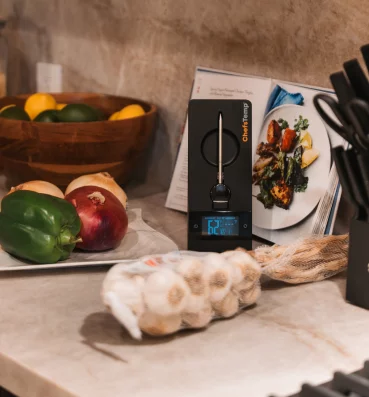FAQ’s
With meat, the most important thing is the interior temperature, which you can’t get with an IR thermometer. IR thermometers are great for getting the temperatures of cooking surfaces such as a pan or grill, but they don’t let you probe into an item.
As an infrared thermometer, Finaltouch IR has a probe which can be used to measure meat temperature.
Our infrared thermometer can tell you the surface temperature of your food, or the surface temperature of your coals. To have a better idea of the doneness, use the probe.
Your thermometer may not be working correctly. Please check the instruction manual to confirm you are using the product correctly. If you are, please contact us.
This infrared thermometer cannot penetrate the glass to measure the internal temperature. It can only measure the surface temperature of the glass.
Using a screwdriver to remove the battery cover on the back and pop out the batteries.
We recommend carefully cleaning the metal probe only with water and soap. For the rest of the body, simply wipe down with a damp towel.
Yes, if you suspect it to be inaccurate, you can re-calibrate this device.
The display will rotate 180° to accommodate both left and right handed users.
It can work for candy that has melted into a liquid state.
It’s important to remember that an instant-read thermometer and a meat thermometer are two different tools. Instant read thermometers are great for taking quick measurements, but meat thermometers are meant to be left inside meat while it cooks.
Bacteria grow most rapidly in the range of temperatures between 40 °F and 140 °F, doubling in number in as little as 20 minutes. This range of temperatures is often called the “Danger Zone.”
To gauge the temperature of a large piece of meat, insert the thermometer probe through the center of the thickest part of the meat, avoiding any bones, fat, or gristle. The thermometer tells you the temp in 1 second, but you can leave the thermometer in the meat for longer if you want to double-check.
The bone is always the coldest part of a steak. If you cook a pork shoulder bone-in, the bone conducts heat deep into the interior. To tell if a roast chicken is done, always measure in the center of the dark meat- and stay away from the bones.
Instant-read meat thermometers are not oven-safe.
Instant-read thermometers aren’t meant to be left in the food while it cooks. Instead, use it to check food towards the end of cooking.
The temperature measurement position is the conical part of the probe tip. The temperature can be measured by inserting the probe into the food for 3-5 mm.
The accuracy of this thermometer is ±0.7℉(0.4℃)
You can not leave it in the oven since the thermometer is a spot check thermometer, and not a leave-in oven thermometer.
A built-in laser helps users target exactly where they’d like to measure, and a backlit display makes reading the temperature easy.
Since the infrared thermometer can precisely measure oven temperatures from outside the oven itself, there’s no safer or more accurate way to measure high temperatures. Another benefit that makes infrared thermometers ideal for cooking is that they can also measure the surface temperature of the pizza itself.
Infrared thermometers are not recommended for use in measuring shiny or polished metal surfaces (stainless steel, aluminum, etc.).
No. Infrared thermometers cannot measure the temperature accurately if there is glass, liquids, or any transparent surface between the subject and thermometer.
Infrared (IR) thermometers enable you to measure temperature quickly, at a distance, and without touching the object you’re measuring. They are so useful, easy, and even fun to use that they have become as common in kitchens as they have on factory floors.
They are gun-shaped and take measurements by using lasers to point at the surface. The pros of this type are the same as the cons of probe thermometers: they can measure those objects that cannot be measured using direct contact. Pros of general-purpose infrared thermometer: No-contact option is safer.
Infrared thermometers are ideal for recording fryer oil temperature (350℉), giving you the ability to perfectly gauge when your batter-dipped chicken is ready to fry.
No. An infrared thermometer will only measure the surface temperature of the water, not the object’s temperature.
Infrared temperature measurement is affected by three main things; emissivity, distance and surroundings. Depending on what you’re pointing your infrared thermometer at you’re going to get a variation in emitted infrared energy. Emissivity is a measure of a material’s ability to emit infrared energy.
The primary use of infrared thermometers is in measuring the temperature of a subject from a distance. The device is beneficial in situations where it is difficult to reach the object to record the temperature.
Infrared thermometers can be calibrated for accuracy, just like other thermometers. In calibration labs technicians use industrial black bodies (like the IR-500 Portable IR Calibrator) to calibrate infrared thermometers.
Substances with very low emissivity ratings, like highly-polished metals, tend to be very reflective of ambient infrared energy and less effective at emitting their own electromagnetic waves. For example, if you were to point an infrared thermometer with fixed emissivity at a stainless steel pot, the reading will be incorrect because shiny metal is better at reflecting the ambient radiation of the room than it is at emitting its own infrared radiation.
Some infrared thermometers have fixed emissivity settings (usually of 0.95 or 0.97) to simplify their operation while leaving them suitable for most organic materials, including almost all foods. Other infrared thermometers come with adjustable emissivity settings, so you can more accurately prepare your thermometer for the type of surface being measured, particularly when measuring non-organic materials.
It depends upon the particular model of infrared thermometer. Consult the user’s manual that came with your thermometer for the full range of features and how to use them.
To be accurate, infrared thermometers must be kept free of dirt, dust, moisture, fog, smoke, and debris. Always take the time to clean your infrared thermometer after exposure to dirty, dusty, smokey, or humid conditions. You should also plan a regular cleaning every six months or so. Particular care should be taken to keep the infrared lens and tunnel clean and free of debris.
To clean your infrared thermometer:
Dip a soft cloth or cotton swab in medical alcohol (never use soap or chemicals).
Carefully wipe the lens first and then the body of the thermometer.
Allow the lens to dry fully before using the thermometer.
Never submerge any part of the thermometer in water.
The “spot size” of any given measurement is controlled by two variables:
The distance-to-target ratio (or spot ratio) of your particular infrared thermometer
The distance between your infrared thermometer and the target
Typically listed on the thermometer itself, the distance-to-target ratio (DTR) – or spot ratio – tells you the diameter of the circle of surface area an IR thermometer will measure at a given distance.
For example, an infrared thermometer with a 12:1 DTR ratio will measure the temperature of a 1-inch diameter circle of a surface area from 12 inches away.
No. Infrared thermometers can only measure the surface temperature of water.
Infrared thermometers do not “see through” glass, liquids, or other transparent surfaces even though visible light (like a laser) passes through them—i.e. if you point an IR thermometer out a window, you will be measuring the surface temperature of the window itself.
When using an infrared thermometer with liquids like soups and sauces, be sure to stir vigorously before taking a measurement to more closely approximate the internal temperature of the liquid. Be aware that steam, even when a liquid is not boiling, can condense on your thermometer and affect the accuracy of your measurements.
Emissivity is a measure of a material’s ability to emit infrared energy. It is measured on a scale from just above 0.00 to just below 1.00.
Generally, the closer a material’s emissivity rating is to 1.00, the more that material tends to absorb reflected or ambient infrared energy and emit only its own infrared radiation. Most organic materials, including the byproducts of plants and animals, have an emissivity rating of 0.95.
If you aim an infrared thermometer at a porous surface like a grill or grate, it will factor in the surface temp of whatever surfaces are visible through the holes of the grill or grate when calculating a final temperature for your reading.
To accurately measure the temperature of a porous grate or grill, place a solid surface like an iron plate or skillet on the grill, let it come to temperature, and measure the plate or skillet. Spray a little cooking oil on the plate or skillet to ensure proper emissivity.
The only way to calibrate a thermometer without ice is to use the hot water method. This method involves setting your thermometer to the temperature of boiling water, 212⁰F or 100⁰C. It is not the safest way to do it but it will work. You need to fill a pot with water and place it on a stove burner and bring the water to a boil, then insert the probe of the thermometer into the boiling water and set the temperature. This way to calibrate a thermometer is not the safest way to do it because you have to place your hands over the boiling water while you calibrate the thermometer. The ice method is the recommended way to calibrate a thermometer.
Cooking thermometers are sold by type. Instant read, oven, candy making, etc…, when you are shopping for thermometer, make sure you read the documentation for the thermometer before you buy it. The ChefsTemp Quad Xpro is one of the best oven thermometers you can get because it has 4 oven thermometer probes on stainless steel leads that are designed to be inserted into the meat, connected to the base unit outside your oven, it will stick to the side of the oven with magnets away from the heat, it also has a stand, and has a remote that you can carry with you and get temperature readings up to 500 feet away. This makes it the most versatile oven-safe thermometer on the market because it will give you accurate temperature readings and you can constantly monitor the cooking process.
There are several steps you need to do to use a food thermometer correctly. First, you need to make sure it is accurate to within two degrees, to do this you need to calibrate it. There are two ways to calibrate a food thermometer. The first is to calibrate using the ice water method. this is done by taking a drinking glass, filling it with ice, then adding water to the ice, then you want to insert the temperature probe into the ice water and once it gets to 32⁰ you then press the set button on an instant-read thermometer or turn the dial on a manual thermometer to 32⁰ and ut we calibrated. The second method is the boiling water method, it is not the safest way to calibrate a thermometer but it will work. First, put water in a pan, place the pan on the burner and bring the water to a boil, then place the sensor probe into the boiling water and press the set/to calibrate button and it will set to the water temperature which should be 212⁰. if you are using a manual thermometer you would then turn the dial to 212⁰.
Any type of brick will suffice for the structure of a grill but firebrick is the most desirable to line the inside. Firebrick will withstand very high temperatures and is denser than most bricks allowing it to hold the heat. It will also even out the temperature if the heat is changeable. A leave-in thermometer will be a great choice to help you keep track of your food temp.
You can also use firebricks to use as a baking surface to bake flatbread, or even to make a smaller oven.
An IP rating is a common added feature for electronic thermometers, particularly electronic cooking thermometers. It is a standard for rating instruments based on their ability to protect their electronic components from corrosion by water or dust created by the International Electrotechnical Commission (IEC). The International Protection Rating code (or IP code) consists of the letters “IP” followed by two numbers.
The first number tells you how protected an instrument’s electronics are from penetration by solids (like dust) and the second number tells you how they stand up against liquids according to the following table:
| First number: Protection against solid objects | Second number: Protection against liquids | ||
|---|---|---|---|
| 0 | No protection | 0 | No protection |
| 1 | Protected against solids objects over 50 mm (e.g. accidental touch by hands) | 1 | Protected against vertically falling drops of water |
| 2 | Protected against solids objects over 12 mm (e.g. fingers) | 2 | Protected against direct sprays up to 15° from the vertical |
| 3 | Protected against solids objects over 2.5 mm (e.g. tools and wires) | 3 | Protected against direct sprays up to 60° from the vertical |
| 4 | Protected against solids objects over 1 mm (e.g. tools, wires and small wires) | 4 | Protected against sprays from all directions – limited ingress permitted |
| 5 | Protected against dust – limited ingress (no harmful deposit) | 5 | Protected against low pressure jets of water from all directions – limited ingress permitted |
| 6 | Totally protected against dust | 6 | Protected against strong jets of water e.g. for use on ship decks – limited ingress permitted |
| 7 | Protected against the effects of temporary immersion between 15 cm and 1 m. Duration of test 30 minutes | ||
| 8 | Protected against long periods of immersion under pressure |
This mainly happens because the temperature is higher than the ice point unless you take the time to create a properly made ice bath. If you do however find that, in fact, the thermometer is outside of its published specification, adjust it accordingly based on the instruction manual or contact our Tech Support team for help by emailing [email protected].
- First, place a solid surface such as a cast iron plate or skillet on the grill and let it preheat for 5-10 minutes.
- Next, spray a little cooking oil on the cast iron’s surface to ensure proper emissivity.
- Finally, measure the surface temperature of the plate or skillet with your IR thermometer.
Can I attach the Quad Xpro thermometer body to the smoker door, or will it break it due to the heat?
Although it has a magnet affixed to the back, the housing is made of plastic and could potentially melt, therefore, it is not recommended to attach it to the smoker door.
This is most likely because your old thermometer is not as accurate as your new digital thermometer. To confirm this, test both thermometers in a properly made ice bath. After checking, adjust your thermometer accordingly or contact our Tech Support team for help by emailing [email protected].
Meat thermometers have probes with the sensor in the tip of the probe. They are designed to be inserted into the thickest part of the meat and give you a real temperature reading. Bone will be hotter due to the nature of bone, so if you insert a probe and it touches the bone it is going to give you a false reading and the meat may not reach the correct safe internal temperature needed to kill any bacteria that may be present in the food. If you insert the probe and it hits the bone, reposition the probe into the thickest part of the meat. Remember, you need to take temperature readings in several separate locations to determine if the food has reached the correct temperature.
Normally, the transmission range is the “best case” range assuming there are no physical barriers between the transmitter and the receiver and no interference from other radio signals. It would be impossible to print a specification that covered “normal” home-user conditions because of the infinitely variable circumstances under which a transmitting thermometer might be used.
Differences in home construction and wall composition is a good example. Concrete, masonry, aluminium siding, metal studs, and metal lathe underneath stucco or masonry are all good inhibitors of radio signals. Interference from other radio signals is also variable (microwaves, cell phones, radio communications, networks, etc.), so the only reliable way to compare device specifications is to give a specification for maximum transmission distance under ideal conditions.
If you want to evaluate whether a manufacturer meets their literal “line of sight” distance claims you should test the device in a rural area with no physical barriers between the transmitter and receiver and little or no interference from other radio signals.
Remember that the more walls and the greater the radio interference the greater the negative impact on your actual transmission distance.
Never leave a thermometer inside an oven, grill, smoker, or microwave while cooking unless it is specifically designed for this.
Don’t leave your thermometer on the grill hood or close to an open flame.
When checking temperatures above a grill or fire, be careful that the thermometer body does not get too hot.
Some probes are designed to be left inside an oven or grill, but the thermometer housing itself (where the electronic components are kept) typically needs to be kept cool and should only be brought near heat for short periods.
Since flare-ups temperature can be over 537°C which will damage the probe. To avoid damage, please keep probe and cable away from flare-ups, grill lids, grill grates or other hot spots with high temperatures over 250°C.
Laser IR Thermometers measure the amount of heat being put out by the food; the laser is used to help you point it to a specific spot to take a temperature. They only measure the surface temperature though. A laser thermometer has no way of reaching the internal portion of the meat where you need to measure the cooking temperature. Laser thermometers are great for measuring the temperature of liquids, soups, water, and pan surface temperatures for things like dry toasting herbs, seeds, chilies, and nuts. A probe thermometer, whether digital or manual, is required to get an accurate internal cooking temperature.
When testing doneness in most cooked foods, the coldest part will be the very center of the thickest portion. With larger foods, you can take quick readings with your thermometer in several locations to verify that the entire portion is done. If you are chilling food, the center of the thickest part will be the last to cool. Most digital thermometers have small sensors at the probe’s tip. Penetrate the food you are checking with the probe and place the very tip of the probe where you want to measure.
If you’re seeing this code on your Receiver, it means it is not receiving the signal from your Main Unit. Follow your device’s instructions for syncing the units.
Step 1: Hold ”VOL” on the Receiver to enter the signal receiving state. After one beep, all data of the Receiver will be reset and the radar icon will begin flashing.
Step 2: Press the ”Signal” button on the back of the Main Unit to send signals manually.
Note:
When the Receiver loses signal for 30 seconds, the alarm will automatically ring, the backlight will be flashing and the Receiver will be vibrating. Press any button on the Receiver to turn off the alarm.
If the Receiver fails to receive the signal for 8 minutes, the signal receiving function will be turned off automatically. Press and hold the ”VOL” button of the Receiver for 2 seconds to restart the signal receiving function.
No, the FinalTouch IR Infrared thermometer is not designed for taking the temperature of the human body. Do not use it to take the temperature of your forehead. This thermometer can not read the internal body temperature of a person. Readings will be incorrect.
There are meat thermometers specifically designed to be left in the meat as it cooks. Some are mechanical thermometers that have a dial and can be left in. Personally, if I am going to use a meat thermometer that can be left in the meat, I use ChefsTemp Quad XPro Alarm Thermometer. This thermometer is designed to leave the probe in the meat and has 4 probes with extra-long leads which attach to a temperature sensing head you are able to affix to the outside of the oven via magnets, or use the kickstand and set it on the counter. It has an alarm to notify you when the meat reaches the desired set temperature.
You have 4 steps to do, we have made an article that explains this, you can check it here.
First, make sure that you have turned your Quad XPro on. The ON/OFF switch is on the back of the unit. If that does not work, we suggest replacing the batteries, as a battery change typically fixes these types of symptoms. If the problem still exists, please contact our customer support for further help.
If your probe was exposed to temperatures above or below its temperature range (-58 to 572°F / -50 to 300°C), you will see an LLL or HHH error.
LLL means that the probe was exposed to temperatures below its range and HHH means that it was exposed to temperatures above its range.
If the probe is not fully inserted into the socket, LLL or HHH may also appear, please remove the probe, and then re-insert the probe fully.
Another reason may be that the probe or socket is damaged, if the problem still exists after re-inserting, please contact our customer service to get help.
The probe of a thermometer can be cleaned and sanitized using these steps:
- Wash the probe with warm water and detergent.
- Sanitize the probe appropriately (alcohol swabs can be used).
- Rinse the sanitizer away if necessary (refer to the instructions on the sanitizer).
- Allow the probe to air dry or thoroughly dry it with a disposable towel.
You can get the most accurate temperature by sticking the thermometer into the center of the thickest part of the meat or casserole. Also, make sure it’s not touching any bone or gristle. For whole chickens and turkeys, the thickest part is where the thigh meets the rest of the body. For thin pieces of meat like hamburgers, stick the probe sideways into the meat.
How do you know if the food is safe to eat and what should be used to check temperature of the food?
The only sure way to know if foods are safe to eat is by measuring the internal cooking temperature of the food in the thickest part of the food. Instant read thermometers are the most effective means of measuring this temperature. The types of instant read thermometers varies greatly. You have mechanical thermometers which you can insert into the food and take a temperature, you have roasting thermometers that you can leave in the food, you can use a digital probe thermometer such as the Smartro ST 54 which has two probes with leads you can leave inserted in the food and get a constant temperature read as the food cooks, and you can use the ChefsTemp Final Touch X10 instant read digital cooking thermometer as well.
